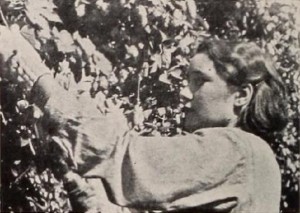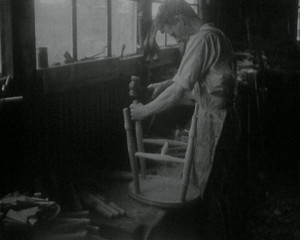"The seven reel industrial film made by Sherman A. MacGregory, ACL, of the construction of a sewage treatment plant was placed among the year's ten best because of its exact and thorough handling of a difficult subject. For more than five months Mr. MacGregory served as construction engineer and cameraman on a job that progressed slowly through many stages. But only by recording in detail all of these stages could he make the film serve its purpose efficiently as an office record — with the result that 4000 feet of 16mm. film were exposed in the process. In the final, carefully edited and titled edition, Mr. MacGregory has achieved and sustained definite interest, even for the layman, in a film subject that threatened monotony at every turn. Unusual and effective camera positions played a large part in this as a complement to the exact production and editing." Movie Makers, Dec. 1932, 560.
"Documentario Industriale"/Industrial Documentary
"The Art of Photo Engraving, 1600 ft., 16mm., filmed by Edward J. Schon, tells the story of photo engraving from the first step to the last. It makes the complete process clear to the nontechnical audience while its interest to the engraver is such that Mr. Schon was invited to attend the recent American Photo Engravers' Convention in Philadelphia to screen the film and speak on his experiences in making it. It is probable that this excellent amateur made industrial has initiated a series of similar films on the same topic. Because of the unusually careful focusing and consistently even exposure, in spite of the wide variety of lighting conditions met with in interior scenes, this film is photographically outstanding. The continuity, presenting the plant's operations in natural sequence, is commendable for its clarity, particularly in view of the numerous complicated processes featured." Movie Makers, Dec. 1930, 759.

"Paul Thompson's Behind the Bale would be an amazing performance for a large studio, equipped with many facilities and numerous staff members, and this is true by reason of the exceedingly careful collaboration between the film editor and the comment writer. For a small producer of industrial pictures, Behind the Bale is a triumph in the technique of post recording, as well as a beautifully made picture that would stand on its own feet without narration and with relatively few titles. A Northwest brewer wishes to make it clear that the quality of hops has much to do with the quality of beer. Therefore, Mr. Thompson shows us the Yakima (Wash.) Valley briefly and then gets down to the special crop which the film pictures. We follow hops through planting, growing, picking and baling, in a Kodachromatic exposition that has rare beauty, and we end with four men enjoying the beer of Mr. Thompson's client. In the entire course of this fine piece of cinematography, there is a wizardry of cutting the film to fit the narration — and the reverse — that produces exposition timed with scene in a fashion that would do credit to the best industrial filmers anywhere." Movie Makers, Dec. 1941, 564.
"BC Packers (Western Canadian Whaling Ltd.) whaling operations, based at Coal Harbour. Whaling ship departs; whale is sighted and harpooned; whale struggles and dies. Flensing and processing of whale carcass at Coal Harbour -- products are frozen ground whale meat and mink feed. Sequence on preparation of harpoons, followed by another whaling trip aboard the Polar V. Several sequences appear to be in slow motion." (BC Archives)
The Western Canada Whaling Company was a sub-division of British Columbia Packers Limited.
The filmmaker is not identified. Film begins with the credit "British Columbia Packers presents..."
"Shows the salmon spawning cycle, methods of commercial purse-seine and gillnet fishing, and processing of the catch at the cannery; includes footage of an "Iron Chink" salmon butchering machine. Filmed at unspecified locations on the BC coast." (BC Archives)
Additional credit: "Produced by the British Columbia Provincial Fisheries Dept."
"The construction of the POM (Pride of Montreal) Bakery in Montreal. Some commercial harvesting footage with baking at POM." (LAC description)

"Making cement for Blue Circle Cement company at the West Medina Cement Works on the Isle of Wight. Footage of the clay fields and chalk quarries, blasting operations, coal and gas retorts, mills, the silos, kiln, clinker being ground into cement, testing for calcium content and crush testing, packing and transport" (EAFA Database).

"The production of components for chairs is compared and contrasted at three locations in the Chiltern Hills" (EAFA Database).
"doc. industriale"
Total Pages: 4